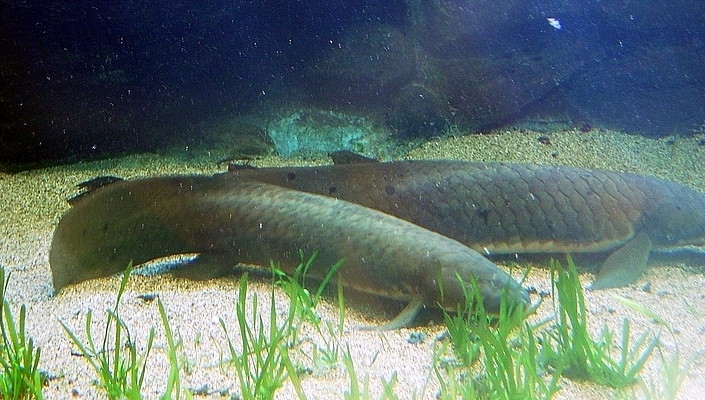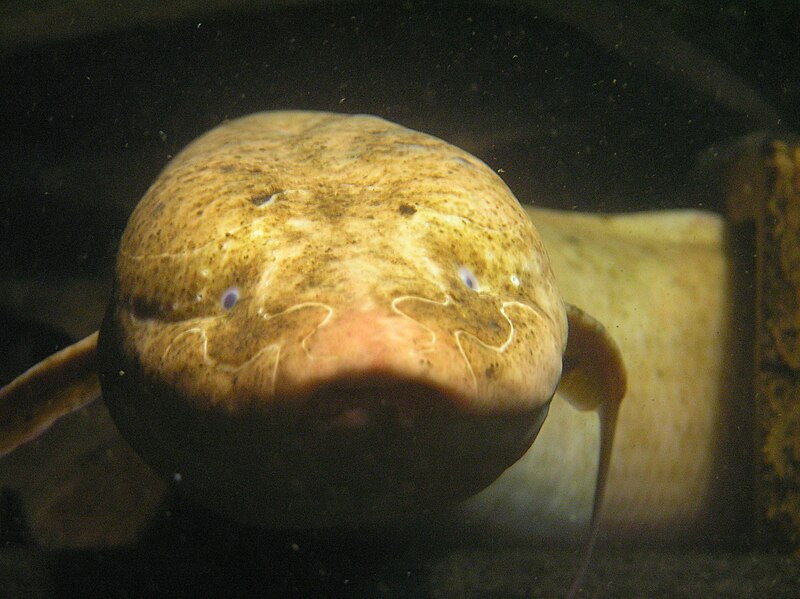 Hello, Frank Indiviglio here. I find it quite easy to imagine a Lungfish-like creature pulling itself from an ancient sea, setting off on land and, in the process, changing the course of life on earth. Indeed, paleontologists believe that a fish very much like today’s Australian Lungfish (Neoceratodus fosteri) pulled off just such a feat during the Devonian Period, some 160 million years ago, and in doing so set the stage for the evolution of all terrestrial vertebrates that followed (talk about “leaving your mark”!).
Hello, Frank Indiviglio here. I find it quite easy to imagine a Lungfish-like creature pulling itself from an ancient sea, setting off on land and, in the process, changing the course of life on earth. Indeed, paleontologists believe that a fish very much like today’s Australian Lungfish (Neoceratodus fosteri) pulled off just such a feat during the Devonian Period, some 160 million years ago, and in doing so set the stage for the evolution of all terrestrial vertebrates that followed (talk about “leaving your mark”!).
Photos showing an African Lungfish being released from a dry mud ball (in The Fishes, part of the wonderful 1960’s Life Nature Library series) hooked me on lungfishes as a boy. As time went on, I had the good fortune to work with 4 species, and my fascination with them grew. I recently helped the Maritime Aquarium to acquire a large specimen for their outstanding Africa, From Desert to Sea Exhibit, and was inspired to write a bit about these amazing creatures here.
Fish or Dinosaur?
Occupying 2 families within the order Lepidosiereniformes, the 6 lungfish species that survive today have barely changed over time – today’s Australian Lungfish, for example, would be difficult to distinguish from those that lived 100 million years ago. Australia and South America are each home to a single species, while Africa boasts 4, including the world’s largest – the massive, 6.5 foot-long East African Lungfish (Protopterus athiopicus).
Lungfishes are believed related to the ocean-dwelling Coelacanth, a true “dinosaur” that lives at depths of 2,300 feet or more. First seen in 1938, when it surprised fisherman by appearing in a net, the Coelacanth was thought to have become extinct 65 million years ago.
The Animal Kingdom’s First Lung
 The swim bladder of the lungfish has evolved into a highly efficient, lung-like breathing organ. By allowing the fishes to use atmospheric oxygen (“breathe air”, as we do) it adapts them well to shallow pools, ditches, swamps and other habitats from which water may disappear during the dry season.
The swim bladder of the lungfish has evolved into a highly efficient, lung-like breathing organ. By allowing the fishes to use atmospheric oxygen (“breathe air”, as we do) it adapts them well to shallow pools, ditches, swamps and other habitats from which water may disappear during the dry season.
This organ is most highly-developed in the 4 African species, some of which can survive periods of up to 4 years without food or water. Droughts are spent within a mucus cocoon, with the fish breathing via a small hole at the top of the protective enclosure.
We’ll take a look at Lungfishes in the aquarium in Part 2. Until then, please write in with your questions and comments.
Thanks, until next time,
Frank Indiviglio
Further Reading
At some point, Lungfish pectoral fins took on a very leg-like form…now paleontologists believe they may have a clue as to just how ancient fishes managed to use their fins to leave the water. Please see From Fin to Leg for the story.
Excellent Animal Planet Video of African Lungfish in and out of water.
Lungfish image referenced from wikipedia and originally posted by Flickr user Belgianchoclate
Queensland Lungfish image referenced from wikipedia and originally posted by Haplochromis
 That Fish Blog – Aquarium Advice and Information
That Fish Blog – Aquarium Advice and Information


Very cool! It’s neat to imagine these guys growing legs and crawling up onto land millions of years ago. Afterall, we all started with gills!
Hello Rachel, Frank Indiviglio here.
Thanks for your interest in our blog.
I agree, and have always been fascinated by the process; one wonders what lungfish, mudskippers, walking catfishes and others will look like in a few million years!
Good luck and enjoy; I look forward to hearing from you in the future. Please keep an eye out for Part II of the Lungfish article, which should be posted shortly.
Best regards, Frank Indiviglio.
Probably they will remain more or less static or go extinct some time. Competition with already adapted land vertebrates will be too strong for these experimenting fish. Or perhapse a major catastrophy will whipe out most tetrapod vertebrates, leaving fish like mudskippers to re-evolve into something similar and take over the previous niches, at least in some more isolated parts of the world. But if those isolated parts of the world come in contact or get by dispersal the already advanced land vertebrates, these fish might go extinct. It seems too difficult to become the next amphibians.